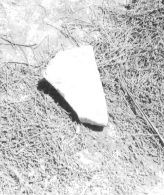EpiDoc XML:
IGCyr1369002
Trismegistos ID:
997631
Source description
Support: Fragmentary limestone panel broken off above, at left and below (preserved dimensions w: 0.085 × h: 0.125 × d: 0.023).
Layout: Scratched on the face, which is more fragmentary than the whole piece (wide 0.05); with a margin left at right for lines 1-4.
Letters: Lightly cut letters with various height (average 0.006); alpha with straight bar, lunate epsilon, pi with shorter right hasta; one monogram for kappa and upsilon.
Date: Possibly second half of second or first half of first century BC (lettering).
Findspot: Plausibly found before World War II at Cyrene ➚: exact findspot not registered.
Place of origin: Findspot.
Last recorded location: Cyrene Museum, 129. Seen in 1979 by Dobias-Lalou in Shahat: Cyrene Museum.
Text constituted from: Transcription from stone and squeeze (CDL).
Bibliography
Never published before this edition.
Text
Apparatus
1,.2,.3,.4: κύ(αμοι) or κύ(αθοι)
French translation
[---]IEPI fèves (ou kyathoi ?), 39
[---]EM fèves (ou kyathoi ?), 12
[---]PRA fèves (ou kyathoi ?), 4
[---]ME fèves (ou kyathoi ?), 10
[---] / 66.
English translation
[---]IEPI beans (or kyathoi?), 39
[---]EM beans (or kyathoi?), 12
[---]PRA beans (or kyathoi?), 4
[---]ME beans (or kyathoi?), 10
[---] / 66.
Italian translation
[---]IEPI fave (o kyathoi?), 39
[---]EM fave (o kyathoi?), 12
[---]PRA fave (o kyathoi?), 4
[---]ME fave (o kyathoi?), 10
[---] / 66.
Commentary
The date is suggested without certainty, as we have no parallel for handscript. Lunate epsilon is the only later clue, whereas mu and pi seem rather similar to the monumental script of late Hellenistic date.
Another feature allowing to place this graffito still into the Greek period might be the ligature ΚΥ, if we interpret it as the abbreviation for 'beans' in the same way as in accounts of the damiergoi (IGCyr0143002 line 11). However, an alternative expansion would be κύαθος, a word itself ambiguous because it is both the word for a 'ladle' and a measure for liquids. Moreover, the ligature might also be read as ΥΚ, for which a tantalizing guess would be ὕκης, a rare word for a fish diversely indentified and mentioned only in fragments. Amongst them, one occurrence is by Callimachus in a non-Doric fragment of epigram, (fr. 394), the other occurrence, resulting from a desperate mention corrected by Bentley (fr. 509), which however would refer to Epirus. The word was considered Cyrenaean by some grammarians earlier than Callimachus, which eliminates the idea that it was labelled Cyrenaean only on behalf of this poet. Anyhow, the nominative, as repeated by several grammatical sources, would not be dialectal. On the whole, this hypothesis remains too obscure to really challenge the κύαμοι or κύαθοι interpretations. The abbreviation seems to have been written twice at line 4.
Line 5 has a contrasting display containing apparently only figures, preceded by an enigmatic /: this might be in this case a symbol for 'total', as the addition of the figures of the preserved lines produces 65; would a number 1 have been mentioned on a lost line above? The hypothesis should be taken cautiously.
The first letters preserved at the beginning of lines 1-4 cannot belong to the end of Greek words or names. They might thus be abbreviated segments of one or two syllables of names, rather than words. Their value is the more obscure that the stone is irregularly broken off on that side.
Despite all those obscurities, this graffito is probably an account accompanying some sort of commercial transaction.
CC BY-NC-SA 4.0 Deed Attribution-NonCommercial-ShareAlike 4.0 International License.
All citation, reuse or distribution of this work must contain a link back to DOI: https://doi.org/10.60760/unibo/igcyrgvcyr2 and the filename (IGCyr000000 or GVCyr000), as well as the year of consultation.


